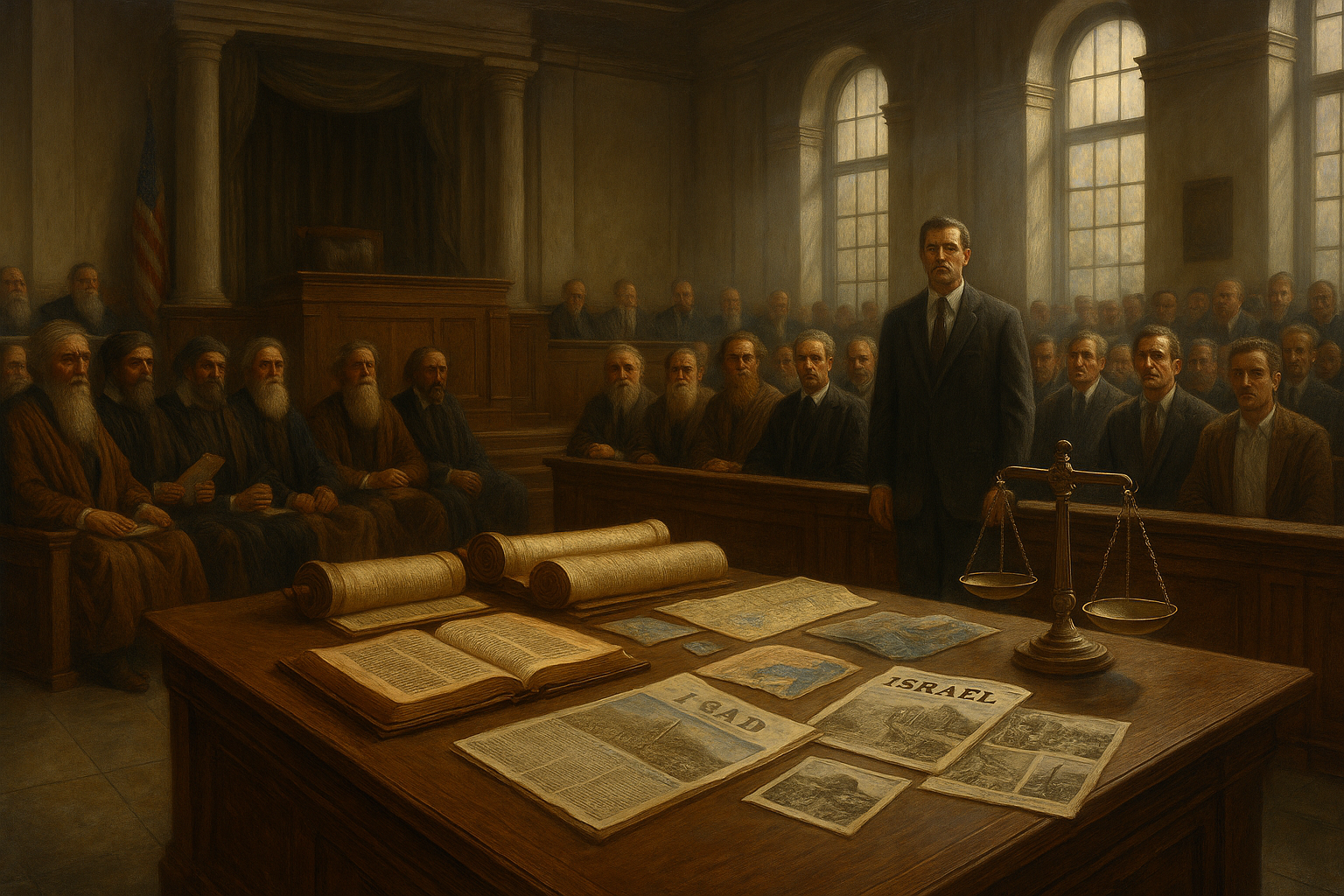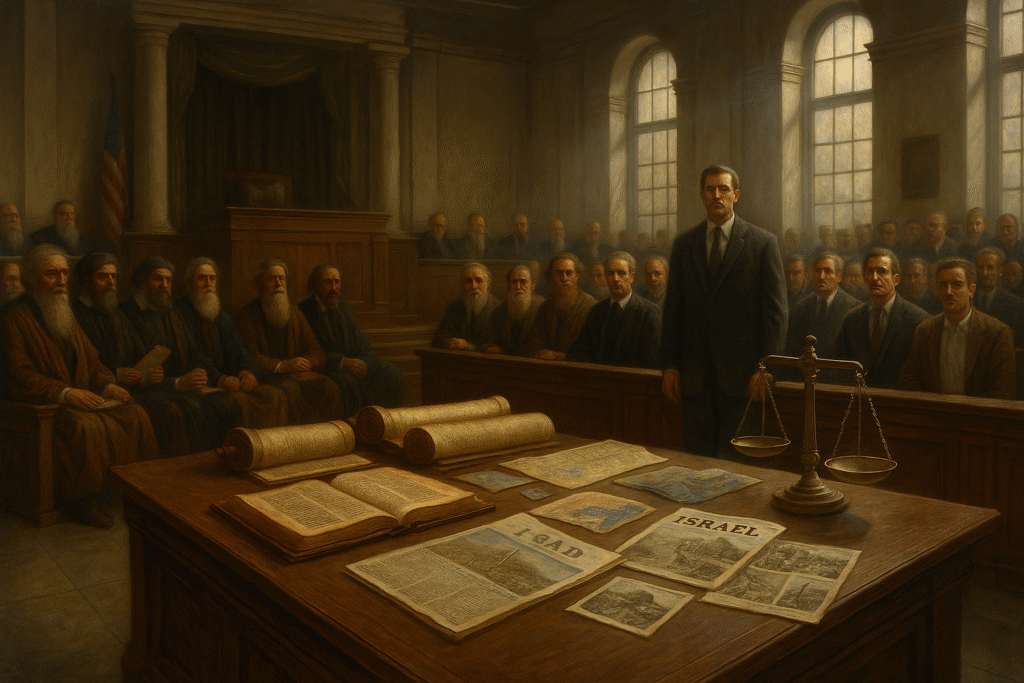Physical Address
304 North Cardinal St.
Dorchester Center, MA 02124
Physical Address
304 North Cardinal St.
Dorchester Center, MA 02124
With Michael Walker
With Michael Walker

We, the jury, find that no defense remains, for the Word has testified, the witnesses have spoken, and history itself has taken the stand….

This is not a plea or a sermon; it is a sworn statement entered into the record of time. It is not speculation but evidence. It is not a tentative hypothesis but a case presented from a position beyond confidence, as one who has handled the exhibits, cross-examined the witnesses, and seen the verdict already written. The hall is not filled with jurors deliberating a murky crime but with humanity confronted by open files stamped “fulfilled.” Every artifact is tagged, every statement corroborated, every line of testimony converging. The existence and activity of Yahweh is no longer a subject for philosophical debate but a matter of public record. The question before us is not “Does He exist?” but “What will we do in light of what He has already proved?” This is a case where the prosecution rests only because the evidence has spoken, not because it needs more.
The first body of evidence is the prophetic corpus itself. J. Barton Payne’s Encyclopedia of Biblical Prophecy catalogs exactly 1,817 individual predictions: 1,239 in the Old Testament and 578 in the New. Of these, over a thousand can be demonstrated as fulfilled in history. That is not conjecture but a numbered index (Payne, Encyclopedia of Biblical Prophecy). Prophecies converge on Yehoshua with a precision that cannot be replicated by chance. Micah 5:2 (NASB) names Bethlehem as the birthplace. Isaiah 53:5-6 (NASB) describes a suffering figure “pierced” and “crushed” centuries before crucifixion was practiced in Judea. Psalm 22:16-18 (NASB) describes hands and feet pierced and garments divided by lot — exactly what John 19:23-24 (NASB) records at the execution of Yehoshua. Genesis 49:10 (NASB) and 2 Samuel 7:12-13 (NASB) establish the lineage from Judah and David. Zechariah 6:13 (NASB) speaks of a priest-king. In ordinary forecasting, the more specific a prediction, the more vulnerable it is to falsification. Yet these texts, written across centuries and preserved by independent scribal traditions, align in a way no human planner could orchestrate. The analogy is a stack of sealed envelopes written generations apart, each one containing details of an event yet to come, and when opened they match the actual outcome in sequence. This is not a string of lucky guesses; it is a signature of intelligence outside the timeline, a Mind writing history from both ends at once. In a court of law, even ten such correspondences would be considered overwhelming; here we have hundreds. The weight is not simply strong; it is category-breaking.
The second body of evidence is eyewitness testimony. Yehoshua’s life was not conducted in a vacuum but among named individuals whose identities are preserved in the very documents that proclaim him. His inner circle included Simon Peter (Cephas), Andrew, James son of Zebedee, John, Philip, Bartholomew (Nathanael), Thomas (Didymus), Matthew (Levi), James son of Alphaeus, Thaddaeus (Lebbaeus/Judas son of James), Simon the Zealot, and Judas Iscariot later replaced by Matthias (Acts 1:26 NASB). Acts 1:21-22 (NASB) stipulates the criteria for replacement: someone who had accompanied them from the baptism of John until Yehoshua’s ascension and could bear witness to his resurrection. Paul’s summary in 1 Corinthians 15:3-8 (NASB) lists the appearances: to Cephas, then the twelve, then over five hundred at once (many still alive at the time of writing), then to James, then all the apostles, then to Paul himself. This is not vague rumor but a roll call of living witnesses. The analogy is a courtroom docket with each witness’s name, address, and occupation listed for cross-examination. Legends grow in anonymity; trials stand or fall on names. Here we have names, dates, and overlapping circles of testimony launched in the very geography where opponents could have refuted it. In modern evidentiary terms, this is devastating to any theory of gradual myth-making. The movement began not in safe territory but under hostile scrutiny and still could not be extinguished.
The third body of evidence is external corroboration by those who neither loved nor followed Yehoshua. Tacitus, Rome’s greatest historian (Annals 15.44), records that “Christus” suffered the extreme penalty under Tiberius by Pontius Pilatus. Josephus, the Jewish historian (Antiquities 20.9.1), notes the death of “James, the brother of Yehoshua who was called Christ.” Pliny the Younger (Letter to Trajan, c. 112 CE) describes early followers singing hymns to Christ as to a god. Suetonius (Lives of the Caesars, c. 121 CE) mentions disturbances “at the instigation of Chrestus.” Lucian of Samosata (2nd century) mocks “the crucified sophist” whose followers worship him still. These are not later preachers but hostile or indifferent observers whose writings survive as part of classical literature. The analogy here is a case where not only do the defendant’s friends testify but the opposing party’s witnesses, with nothing to gain and something to lose, confirm the basic facts. In legal language these are admissions against interest — the most credible kind of testimony. Even modern secular scholars hostile to faith, such as Bart Ehrman, Gerd Lüdemann, and Maurice Casey, state unequivocally that the existence of Yehoshua is beyond serious doubt. Ehrman writes, “Virtually every competent scholar of antiquity agrees that Yehoshua existed” (Did Jesus Exist?, HarperOne 2012). At this point the debate shifts from “Did it happen?” to “What does it mean?” The defense can no longer claim absence of evidence; it is reduced to disputing interpretation.
The fourth body of evidence is the modern restoration of Israel itself. Deuteronomy 30:1-5 (NASB) foretells dispersion and regathering. Ezekiel 37 (NASB) describes a valley of dry bones reassembled into a living nation. History matches prophecy with unnerving precision: exile by Assyria in 722 BCE, exile by Babylon in 586 BCE, partial restoration under Cyrus in 538 BCE, destruction of the temple by Rome in 70 CE, and final dispersion after the Bar Kokhba revolt in 135 CE (recorded in Roman imperial archives). For nearly two millennia the Jewish people lived scattered, persecuted under medieval Europe, the Ottoman Empire, and Russia, enduring pogroms, ghettos, and the Holocaust. By every sociological measure such a people should have vanished, their language lost, their identity dissolved. Yet in the late nineteenth century the Zionist movement under Theodor Herzl gained momentum. The Balfour Declaration of 1917 pledged British support for a homeland. In 1947 the United Nations voted for partition (UN General Assembly Resolution 181). On May 14, 1948 David Ben-Gurion declared the rebirth of the State of Israel. Hebrew was revived as the national language under Eliezer Ben-Yehuda. The shekel returned as currency. The Knesset convened as sovereign government. The Israel Defense Forces formed. Jerusalem was recaptured in 1967 during the Six-Day War. The analogy is staggering: imagine if the United States were obliterated, its people scattered worldwide for two thousand years, its language fading, its Constitution forgotten, and then in one generation the entire nation reappeared, English restored, the dollar minted, Congress seated, armies defending its borders. Such an event would be judged extraordinary beyond natural cause. Yet that is what occurred with Israel — and it was foretold thousands of years in advance. This is not hidden fulfillment but open-air prophecy in front of nations, radio broadcasts, and photographic archives. The governments that saw it range from the British Empire and the League of Nations to the United Nations, the United States, the Soviet Union, and every state that has had to acknowledge Israel’s rebirth on its maps. Bones took on flesh in daylight.
The fifth body of evidence is the involuntary corroboration of skeptics. When leading critics, historians, and textual scholars with no stake in promoting faith affirm the existence of Yehoshua, the persecution and dispersion of Israel, and the historical authenticity of core events, they act as opposing counsel stipulating to the facts. This is like a defense attorney standing up in court and saying, “We concede the fingerprints, the DNA, and the video footage. We only dispute what it means.” Such concessions strip away the last refuge of denial. The issue is no longer whether but why, no longer fact but interpretation. Once at this point, naturalistic explanations become increasingly contrived.
The combined weight of these five bodies of evidence forms a cumulative case that no single alternative theory can neutralize. In law this is called converging lines of evidence — fingerprints, DNA, surveillance, and confessions all pointing to the same suspect. Courts instruct juries that the probability of coincidence is beyond reasonable doubt. Here we have prophecy as motive, control over history as opportunity, named eyewitnesses as testimony, Israel’s restoration as forensic proof, and the Word’s own claim as confession. This is not circumstantial only but direct and circumstantial together. In criminal trials such a case ends in conviction. In the cosmic courtroom it ends in acknowledgment: Yahweh has testified under oath in history, and the exhibits are in our hands.
The implication is not merely that “a God” exists but that the God who exists is the covenant-making, prophecy-keeping Yahweh who reveals himself in Yehoshua and in the preservation of Israel. The Word is not only about God but is Exhibit A of God — the only self-authenticating text whose predictions, witnesses, and living signs converge across millennia. This moves the discussion from metaphysics to summons. Disbelief at this point is not rooted in lack of evidence but in a volitional refusal to accept what is before one’s eyes. Romans 1:20 (NASB) describes people as “without excuse” because God’s invisible attributes are clearly seen. The case here shows not only invisible attributes but visible acts. The Author has gone on record, binding his identity to verifiable acts in history.
There is no coherent defense that neutralizes all pillars at once. Skeptics can try to fragment the case — treating prophecies as coincidence, witnesses as legend, Israel as politics — but when viewed together these explanations contradict one another and collapse. The cumulative case stands. The only remaining defense is willful dismissal — not a counter-argument but a choice. In any other domain of inquiry, this would already be considered settled beyond reasonable doubt.
Thus we arrive at the verdict. The evidence does not merely suggest but compels. Over a thousand fulfilled prophecies imply foreknowledge and orchestration. Named eyewitnesses imply public reality able to withstand scrutiny. External hostile sources imply involuntary corroboration. The unthinkable restoration of Israel implies a living, active covenant-keeping God still moving in history. The acknowledgment of the Messiah by secular scholars implies the facts are so solid they cannot be denied even by opponents. Together they do not simply prove that God exists but that Yahweh, the covenant God of Israel, has inscribed his hand on time. He has signed the document of history, stamped it with fulfillment, and left it on the bench for the world to read. The record is sealed not in secrecy but in completion. The hall is silent not because persuasion has triumphed but because the evidence itself has spoken. This is beyond irrefutable. Yahweh is not only real but active, and the convergence of prophecy, witness, history, and nationhood is his signature in open court. The verdict is entered. The question is no longer “Is God real?” but “What will you do now that the case has been proven?